Wine Decanter Guide (7 Types, How to Use, Buying Tips)
Wine decanters are often seen as something used only by sommeliers or wine snobs. But, it’s a great tool to have in your arsenal if you’re a red wine drinker (novice or expert!)
You’ll be able to savor the flavors better and immerse in all the subtle aroma layers, which you may not be able to detect otherwise.
This article will tell you what a decanter does, how to decant wine of various styles, the different wine decanter types, buying tips, and more. If you want to build a collection of wines, we’ll also share an easy way to create your own portfolio of red wine and others.
Further reading
- Discover the world of investment-grade wines with our comprehensive guide to Wine Investment.
- Or dive into the world of red wine and explore the most elegant Barolo wines, the best Dry Red Wines, and the most elite Red Wine Brands.
What Is A Wine Decanter, And Why Do You Need One?
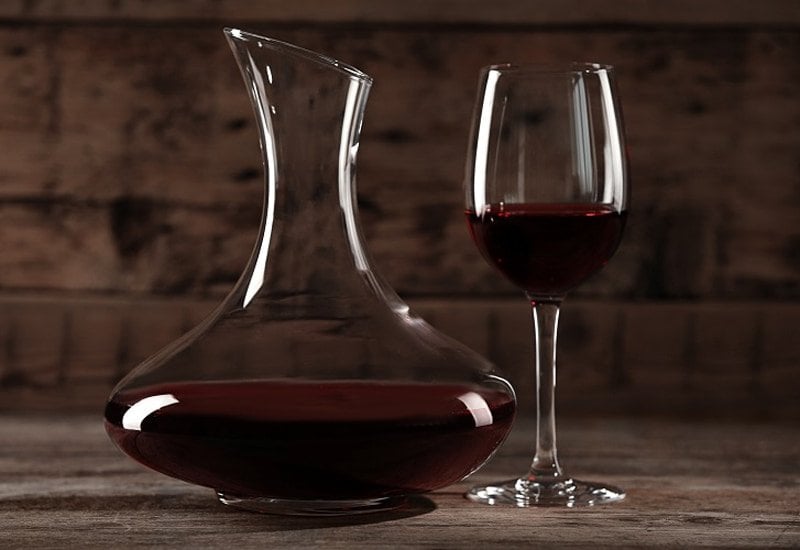
A wine decanter is a glass or crystal container you can pour your wine into before drinking it. The decanter helps the wine breathe and enhances its flavors and aromas.
Most people use decanters for red wines as they’re more tannic and dense in taste. Allowing them to breathe softens the texture and tannins of the red wine. A decanter works well for both affordable and more expensive red wine bottles.
Using a wine decanter will let you enjoy the subtle nuances of your red wine - whether you’re a seasoned wine expert or an amateur wine lover.
But how does decanting improve your wine-drinking experience?
When you buy a bottle of wine, it’s already been sitting in the bottle for a very long time. So decanting will do the following:
- Aerate the wine: Once the trapped wine is poured into the decanter, the wine is introduced to oxygen and the aeration process begins. Thanks to the wine oxidation, you’re introduced to many new aromas and taste notes that usually stay concealed before aeration. Aeration also smoothens the tannins and removes any bitterness in the wine’s flavor.
- Remove any sediment: Older red wine vintages usually contain sediment. Even though sediment is not harmful to you, it could affect the wine’s taste and aroma. Decanting helps you pour only the clear liquid and leave out the sediment in the bottle.
Many people refer to a wine decanter as a wine carafe.
Wine decanters and carafes, however, are different.
Difference Between A Wine Decanter And A Carafe

A wine decanter usually has a long neck and a large surface area around the base that helps to aerate the wine.
A carafe is a cylindrical container with a shorter neck and a much smaller breathing area. A carafe can be used for light red, white, or rose wine.
A carafe It could also be used for any other alcoholic beverage, water, or juice.
Want to take your wine game to the next level? Add a decanter, a wine carafe or even a wine aerator to your home bar and instantly elevate your wine drinking experience!
Fun fact: You can use your decanter for other alcoholic beverages like whiskey, bourbon, cognac, and scotch. You can also use a whiskey decanter to decant wine, especially if you’re not consuming it immediately.
So how do you use a decanter?
How To Use A Decanter

It’s as simple as pouring the wine from the bottle to the decanter.
But there are a few subtleties to the technique that any wine enthusiast should be aware of:
- If you have an aged bottle of red wine, stand the bottle upright for 24 hours so all the sediment can settle at the bottom of the bottle.
- Prepare your wine decanter and wine glass, and open the bottle.
- Pour the wine slowly into the decanter at a 45-degree angle, making sure it hits the sides of the glass. This will accelerate the wine aeration process.
- Hold a flashlight or candle under the neck of the bottle. If you’re pouring an older wine, this trick will help you see the sediment more easily.
- Stop pouring as soon as you see sediment at the neck — you’re looking for specks of dust or cloudiness.
- Give the decanter a swirl after you finish pouring for further aeration and set it aside.
- Once aerated, you can pour the wine from the decanter into your glass.
Inexpensive young wine usually has little to no sediment and you can speed up the oxidation process through shock decanting:
- Pour a little wine into the decanter, re-cork the bottle and shake well. When you shake the bottle, you’re speeding up the aeration process.
- Pour the rest into the decanter and wait for about 20 minutes before serving in your wine glass.
How long should you allow the wine to breathe in a wine decanter?
How Long to Decant Different Types of Wine
It can take anywhere upwards of 15 minutes to decant wine depending on the wine style.
Here’s a quick summary:
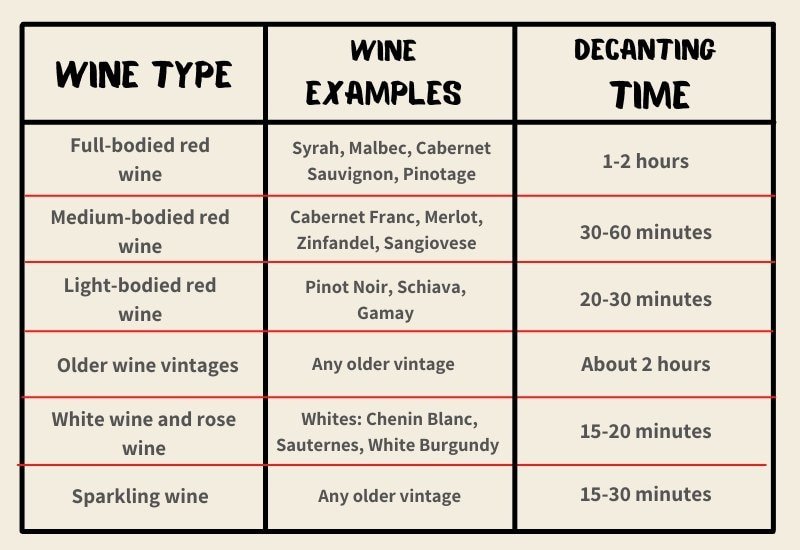
Once your wine is decanted, you just have to sit back and savor the flavor of the wine!
To truly understand how the flavor evolves, pour yourself a little wine before decanting and make a note of its taste. Then, after you decant the wine, taste it again and compare notes.
Now that you know how to use a wine decanter let’s explore how you should select one.
How To Choose The Right Wine Decanter
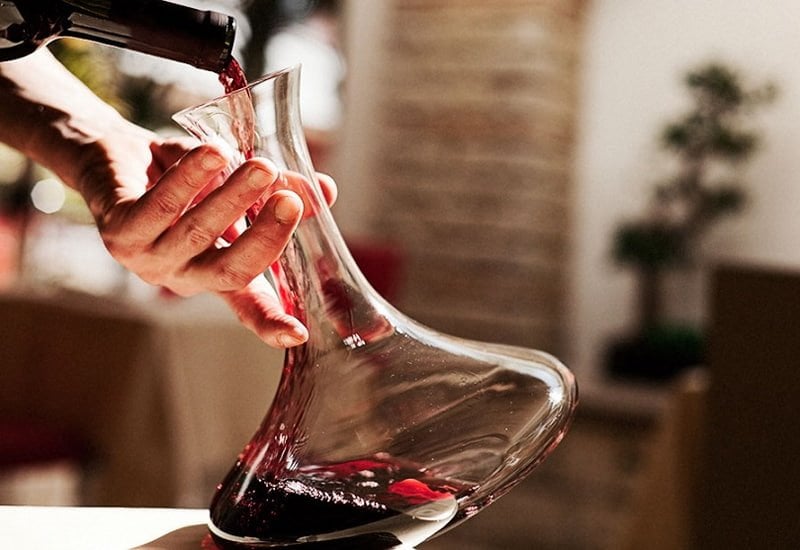
When selecting a wine decanter, there are few aspects to bear in mind:
1. Size
Depending on how much wine you decant (one glass or one to two bottles), you can choose:
- Small wine decanters: They are ideal for decanting a glass or two.
- Medium wine decanters: This is the standard size in which you can decant up to one standard bottle (the usual preference.)
- Large wine decanters: These decanters are great if you need to decant more than one bottle. But remember, the wine may not breathe as effectively if there’s a lot of liquid in the decanter, so aim for 1-1.5 liters at a time. Full-bodied and younger wines can aerate faster in large decanters.
2. Shape
There are different shapes to choose from like standard, U-shaped, bell-shaped and more. You can choose one depending on how much surface area your wine needs.
Also, consider how easily you can pour the wine after decanting. Pick a wine decanter with a good grip so you prevent any spills and feel comfortable when pouring.
3. Material used
Most wine decanters are made of glass and the higher-quality, more expensive ones are made of crystal glass.
Any other type of material (like plastic, recycled glass, or stainless steel) will affect the wine’s flavor.
Here are the main differences between crystal and standard glass wine decanters:
- Crystal decanter: These high-quality decanters are very durable. Glassware makers use this material for larger, more artistic-looking decanting vessels.Some crystal wine decanters might contain small amounts of lead, but these are not dangerous if your wine doesn’t spend a long time in the vessel.
If you want a crystal decanter, go for lead-free crystal.
- Standard glass decanter: These decanters have thicker walls and simple, classic shapes. If you want an ornate standard glass decanter, make sure it’s made with borosilicate glass. Compared to other types of glasses, borosilicate glass is more resistant to thermal shock.Standard glass wine decanters are also dishwasher safe.
4. Other factors
- Type: Besides the traditional decanter, you can also buy an electric decanter which can aerate your wine in record time.
- Design: Visually pleasing wine decanters like the handblown ones look beautiful on display at your dinner table or at a party.
- Wine style compatibility: Many glassware companies market different decanters for different wine styles.
- Filtering: If you’re an aged wine lover, wine decanters with a strainer attached will catch the sediment easily.
- Wine decanter with a stopper: Wine goes rancid when exposed to air for too long. So get a wine decanter with a cork or stopper if you won’t finish a bottle in one sitting.
Let’s now find out which types of wine decanters are worth your buck.
7 Different Types of Wine Decanters To Buy In 2021
These are some of the best wine decanters to add to your home bar:
1. Standard Wine Decanter

The standard wine decanter is ideal for both wine experts and amateur wine lovers.
It comes in a classic shape with a circular wide base and a tall spout. Some decanters have an angled spout for easy pouring.
Some of the popular standard decanters are:
- Schott Zwiesel decanter
- Riedel decanter
- Le Chateau wine decanter
2. U-Shaped/ Swan Wine Decanter
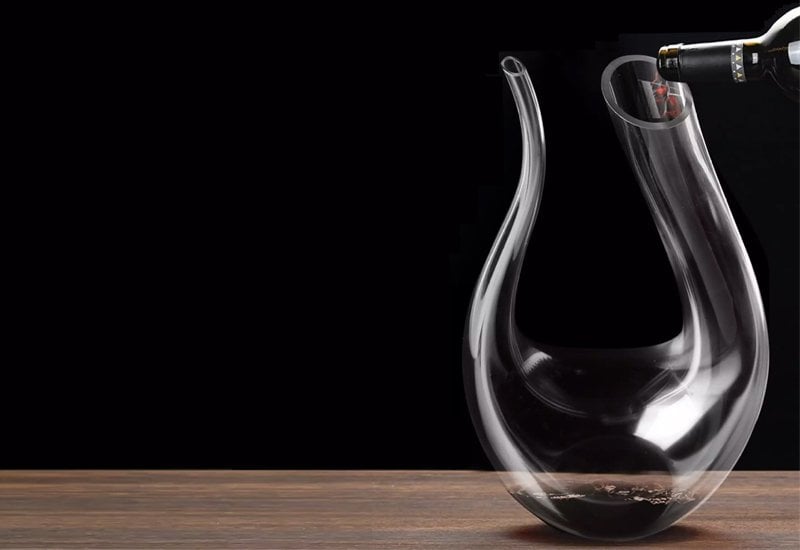
This decanter comes in a U-shape (also called a swan-shaped decanter.) It has two spouts — one wide and one narrow.
The narrow spout has a slight “S” shape that makes it easy to grip and pour the wine into a glass. Both ends of this decanter can be used as a handle and a spout.
3. Snail-Shape Wine Decanter
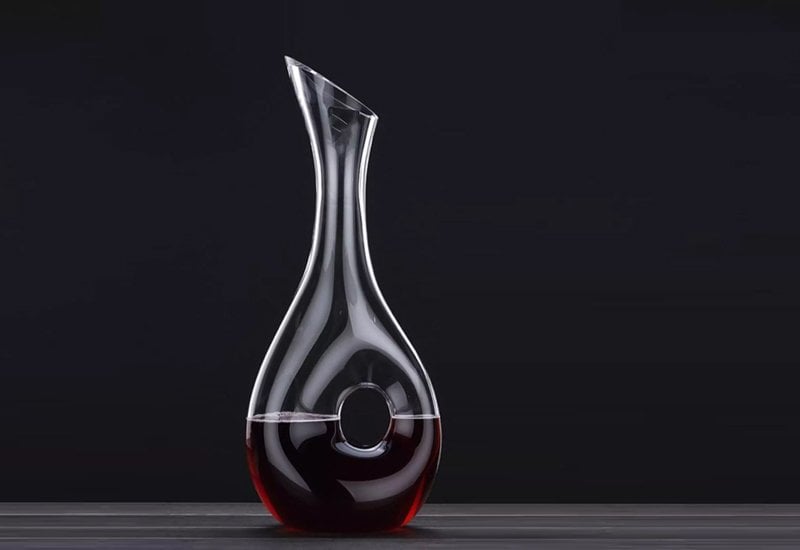
This wine decanter has an opening in the middle, giving it a snail-shaped look. The decanter has a wide base and the design allows for a good grip when pouring wine.
4. Wine Decanter with Strainer
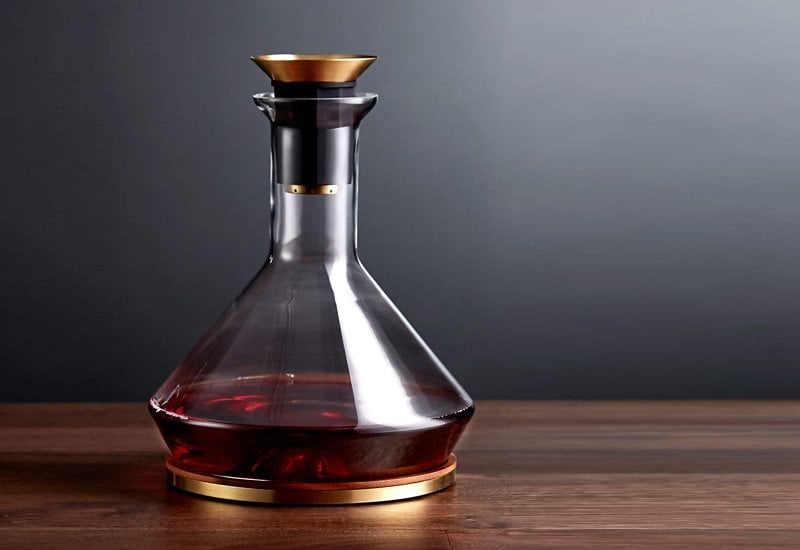
Some glassware brands have wine decanters with an attached strainer to their spout. This type of wine decanter is ideal for aged wine.
It offers an extra filtering layer and prevents the wine sediment from mixing with the clear liquid.
5. Bell-Shaped Wine Decanter

This decanter is durable with a practical design. The base has a punt that helps in collecting sediment and pouring.
6. Wine Decanter Breather
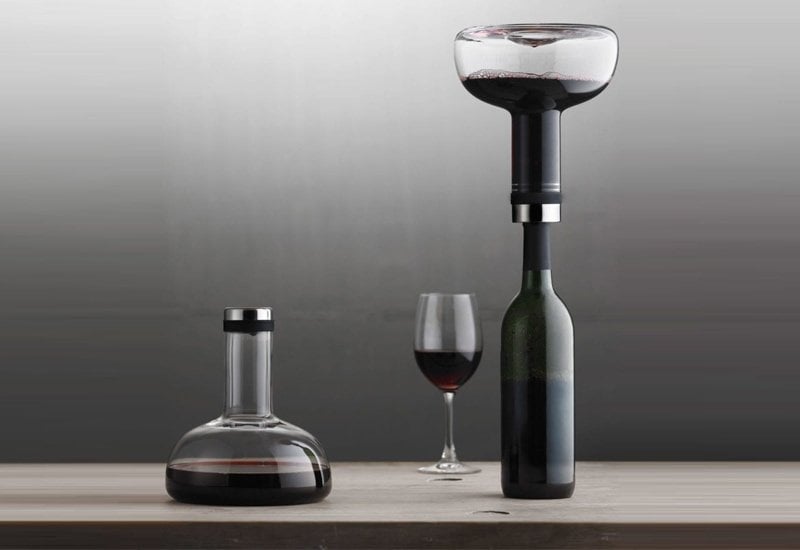
The wine decanter breather can latch onto the wine bottle neck (such wine decanters are great for younger wines with no sediment.)
The wine decanter breather can latch onto the wine bottle neck (such wine decanters are great for younger wines with no sediment.)
Once latched, you just have to flip the bottle. This way, the wine splashes onto the decanter walls and the aerating process is accelerated.
If you don’t finish the wine, you can reattach the original bottle to the decanter, flip it over and store the leftover wine in the bottle.
7. Electric Wine Decanter
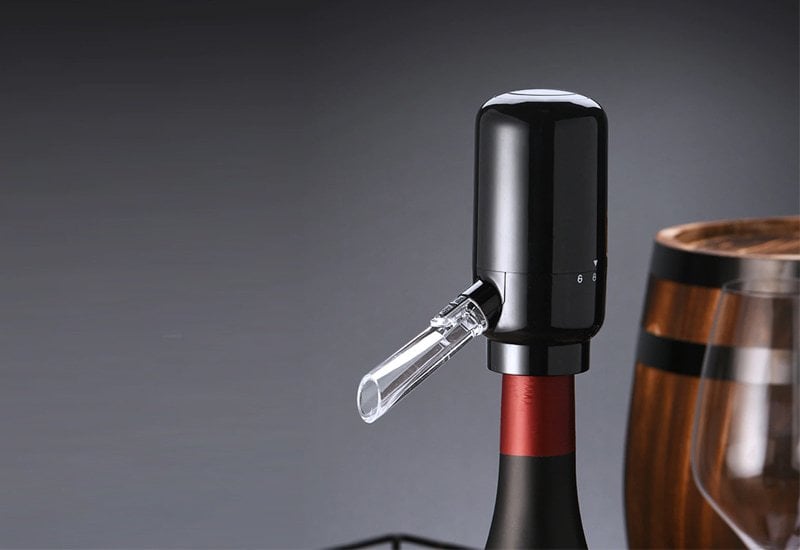
This technology-driven wine decanter sits on a powerful base that speeds up the wine’s decanting time by passing air through a tube inside the decanter.
Some decanter devices also have mobile apps that allow you to control decanting wine from your phone. Hand washing is the best way to clean a decanter like this.
Now:
A wine decanter needn’t be the only wine tool at your disposal for aeration and removing sediments.
Other Decanting Tools
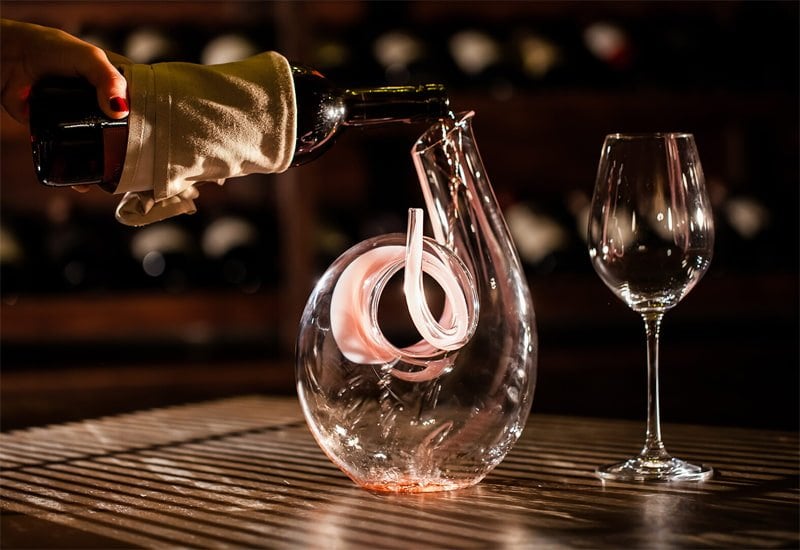
Here are other wine bottle add-ons that can accelerate the wine aeration and also add an element of fun to your party:
- Aerator: An aerator is a small accessory you attach to your wine bottle or hold above your glass. A wine aerator helps wine breathe and typically doesn’t filter it.
- Decorative Pourer: A pourer is an attachment that latches onto the wine bottle. Pourers come in different designs and make your wine serving experience more memorable — perfect for any wine enthusiast! They keep wine spills to a minimum and look great on top of your bottle.
- Wine Purifier: Using a wine purifier is not a common practice for a wine expert, but it’s a useful tool to have. A wine purifier is a small tool that locks onto the bottle and removes the sulfites present in wine — ideal for those with allergies. It also aerates and removes sediment from the wine as it pours into the glass. It’s a great decanting solution if you’re on the go.
Next, let’s find out how you should clean your decanter.
How to Clean Your Wine Decanter
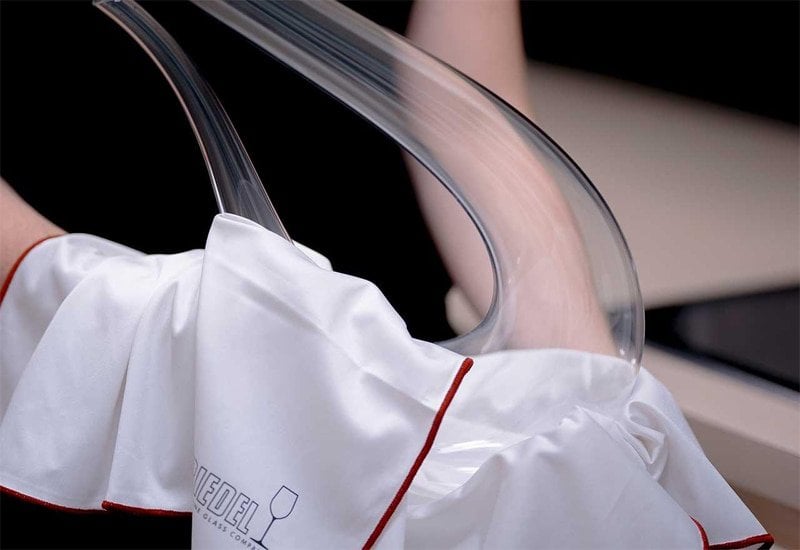
Cleaning a decanter isn’t always easy — some decanters are dishwasher safe, but others require a more hands-on approach.
Here are some tips to remember:
- Use fragrance-free soap: When cleaning your decanter, use a fragrance-free soap so your wine doesn’t get any soapy odors.
- Buy a decanter cleaner: This is a long pipe cleaner with a handle that will easily reach the bottom of your decanter. If you have a more intricate vessel, get some cleaning beads to navigate hard-to-reach areas.
- Dry the decanter well: Let your decanter drain in a large bowl lined with a paper towel or cloth napkin. Alternatively, invest in a decanter dryer.
- Buy a wine decanter set: A set like New Pacific YouYah includes a cleaning brush and drying stand. You can also use the drying stand to hold your decanting wine. This also makes a good gift set for any wine lover.
Now that you’re armed with everything to know about decanting wine, it’s time to put your skills to good use.
You could start by decanting any new red wine you buy from your local wine shop.
But, if it’s the rarer, investment-grade red wines that you’re after, a wine store may not be your best bet.
The easiest way to build a collection of rare wine collectibles is through Vinovest!
Buy Exclusive Fine Wines Through Vinovest
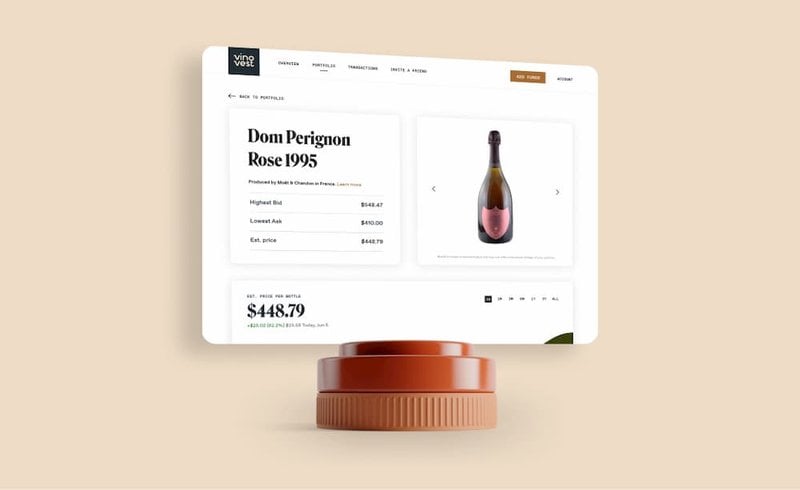
Vinovest is a wine investment firm that buys, authenticates, stores, and sells your favorite wine for you.
Benefits of Building a Wine Collection Through Vinovest
Grab a glass of your favorite sparkling wine, sign up, and enjoy these spectacular benefits:
- You can buy and sell your wine with just a few clicks of your mouse, thanks to Vinovest’s AI platform.
- You get your wines at the best prices as Vinovest directly sources bottles of wine from wholesalers, wine merchants, and global wine exchanges.
- Vinovest’s team of master sommeliers will handpick the best wines to build you a winning portfolio. They’ll also make sure your wine is authentic by tracing its provenance.
- Vinovest stores your wine safely in bonded warehouses under optimal conditions.
- You will have access to private wine company sales and wine tasting events with notable winemakers.
- Vinovest will deliver your bottle of Pinot Noir or Cabernet Sauvignon wine to your doorstep, as a gift to your wine drinker friends, or to a buyer, no matter the location.
Decant Your Fine Wine Like A Pro
Your wine decanter will let you taste the nuanced flavors of your favorite wine completely - elevating your wine drinking experience!
As you enjoy your decanted glass of red wine, consider adding a bottle or two of fine, investment-grade wine to your collection. Just sign up with Vinovest to start building your curated wine portfolio now.



